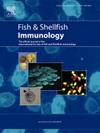Black carp RNF135 enhances RIG-I-mediated antiviral signaling by facilitating its oligomerization
IF 4.1
2区 农林科学
Q1 FISHERIES
引用次数: 0
Abstract
RNF135, also known as RIPLET, plays a crucial role in facilitating RIG-I signaling in mammals. However, the function and regulatory mechanism of RNF135 in teleosts remain much to be elucidated. In this study, RNF135 homolog of black carp (bcRNF135) has been cloned and identified. The coding sequence (CDS) of bcRNF135 gene comprises 1221 nucleotides, encoding a protein of 407 amino acids. Immunoblotting (IB) and immunofluorescence (IF) assays identified that bcRNF135 is approximately 50 kDa and localized in the cytoplasm. qRT-PCR demonstrated that bcRNF135 mRNA levels were increased in host cells following SVCV infection and poly (I:C) stimulation. Co-expressed bcRNF135 obviously enhanced the induced transcription of IFN promoters by bcRIG-I in reporter assay, as well as improved bcRIG-I triggered antiviral response. Notably, bcRNF135 knockdown reduced the antiviral ability of host cells and increased virus replication. Co-immunoprecipitation (Co-IP) assays and IF assays confirmed that bcRNF135 interacted with bcRIG-I. Moreover, SDD-AGE revealed that bcRNF135 promotes the oligomerization of bcRIG-I, a process critical for RIG-I activation. Overall, our data conclude that bcRNF135 enhances bcRIG-I-mediated antiviral signaling by facilitating its ubiquitination and oligomerization, enriching our understanding of RIG-I regulation in teleost innate immunity.
黑鲤 RNF135 通过促进 RIG-I 的寡聚化来增强 RIG-I 介导的抗病毒信号传导
RNF135 又称 RIPLET,在哺乳动物中对促进 RIG-I 信号传导起着至关重要的作用。然而,RNF135在远洋鱼类中的功能和调控机制仍有待进一步阐明。本研究克隆并鉴定了黑鲤的 RNF135 同源物(bcRNF135)。bcRNF135 基因的编码序列(CDS)包括 1221 个核苷酸,编码 407 个氨基酸的蛋白质。免疫印迹(IB)和免疫荧光(IF)分析表明,bcRNF135 的分子量约为 50 kDa,定位于细胞质中。qRT-PCR 证实,在 SVCV 感染和 poly (I:C) 刺激后,宿主细胞中的 bcRNF135 mRNA 水平升高。在报告实验中,共表达的 bcRNF135 明显增强了 bcRIG-I 对 IFN 启动子的诱导转录,并改善了 bcRIG-I 触发的抗病毒反应。值得注意的是,敲除 bcRNF135 会降低宿主细胞的抗病毒能力并增加病毒复制。共免疫共沉淀(Co-IP)检测和 IF 检测证实了 bcRNF135 与 bcRIG-I 的相互作用。此外,SDD-AGE 显示 bcRNF135 促进了 bcRIG-I 的寡聚化,而这一过程对于 RIG-I 的激活至关重要。总之,我们的数据得出结论,bcRNF135通过促进bcRIG-I的泛素化和寡聚化,增强了bcRIG-I介导的抗病毒信号转导,丰富了我们对RIG-I在远缘鱼类先天免疫中的调控的认识。
本文章由计算机程序翻译,如有差异,请以英文原文为准。
求助全文
约1分钟内获得全文
求助全文
来源期刊

Fish & shellfish immunology
农林科学-海洋与淡水生物学
CiteScore
7.50
自引率
19.10%
发文量
750
审稿时长
68 days
期刊介绍:
Fish and Shellfish Immunology rapidly publishes high-quality, peer-refereed contributions in the expanding fields of fish and shellfish immunology. It presents studies on the basic mechanisms of both the specific and non-specific defense systems, the cells, tissues, and humoral factors involved, their dependence on environmental and intrinsic factors, response to pathogens, response to vaccination, and applied studies on the development of specific vaccines for use in the aquaculture industry.
 求助内容:
求助内容: 应助结果提醒方式:
应助结果提醒方式:


